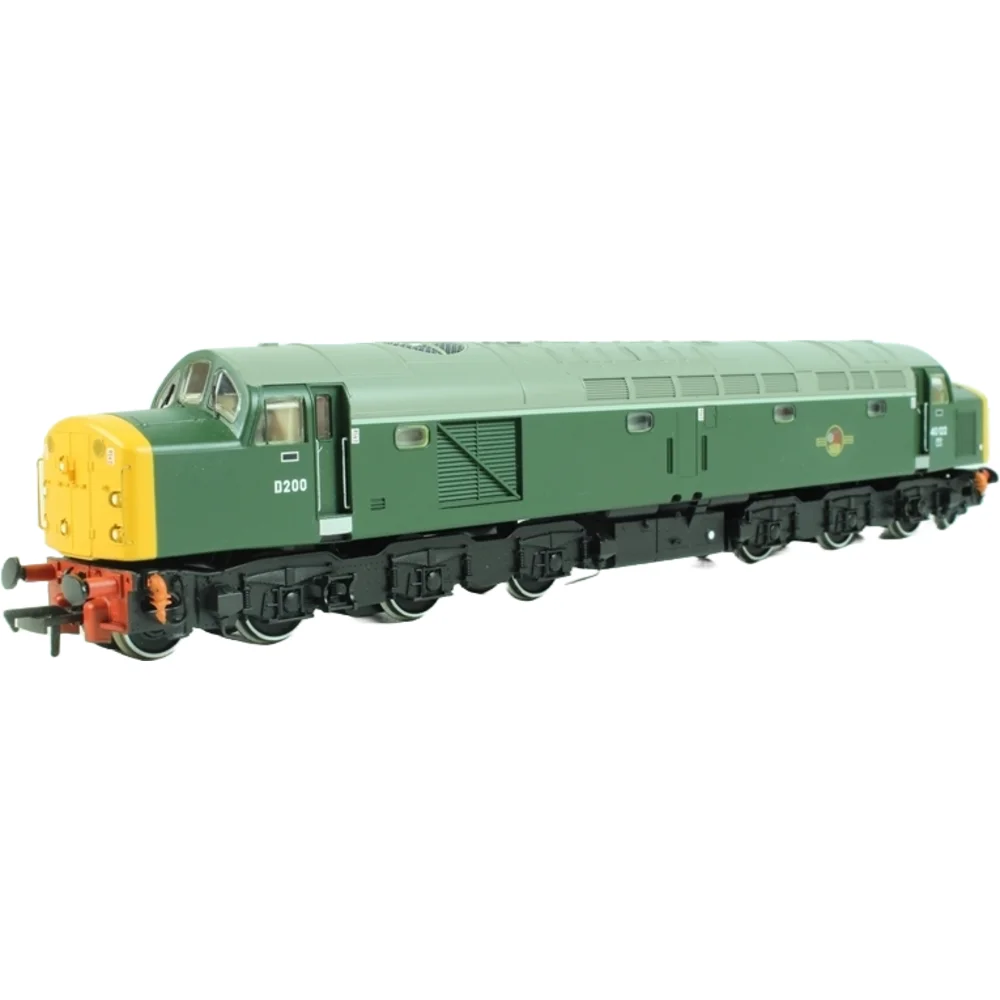Bachmann 32-475Z
British Rail Class 40 D200 British Railways Green with Late Crest
Tooling
Bachmann introduced its OO gauge model of the British Rail Class 40 in 2003 as part of its Branchline range. This release marked a significant step forward from earlier models by other manufacturers, offering improved accuracy and detailing for one of British Railways’ most iconic diesel locomotives. The Class 40, known as the “Whistler,” was a mainstay of express passenger and heavy freight duties from the late 1950s through the 1980s, making it a popular choice for modellers of the transition and BR blue eras.
Tooling Features
- Scale: OO gauge (1:76).
- Construction: Plastic bodyshell with separately fitted details; diecast chassis for weight and stability.
- Detailing: Etched fan grille, separately applied handrails, lamp irons, jumper cables, and bufferbeam pipework (some supplied in accessory pack). Sprung buffers and detailed cab interiors with seats and glazing.
- Couplings: NEM pockets with tension-lock couplers.
Mechanical & Electrical
- Motor & Drive: Five-pole motor with twin flywheels, centrally mounted, driving all six axles via a robust gear train.
- Pickups: Electrical pickup on six of the eight axles.
- Minimum Radius: Second radius curves (approx. 438mm).
- Lighting: Directional headlights and tail lights, plus illuminated headcode panels.
- Weighting: Integrated within the diecast chassis for improved adhesion.
DCC Capability
DCC Ready with an 8-pin socket. Space was provided for a 20x40mm speaker for those wishing to add sound. Models were supplied with a blanking plate for DC operation.
Liveries Produced
- BR Green with early emblem (circa 1948–1957).
- BR Green with late crest (circa 1957–1972).
- BR Blue (circa 1965–1990).
Variants included disc headcode and centre headcode versions, with limited editions for enthusiast groups and magazines.
Reviews & Commentary
The 2003 tooling was widely praised for its accurate body shape, fine detailing, and smooth running qualities. Reviewers highlighted the etched fan grille and separately fitted parts as standout features. Some minor criticisms included slightly shallow bogie detail and occasional running-in issues, but overall reception was positive. Enthusiasts appreciated the model’s weight and haulage capability, making it suitable for prototypical long trains.
Media & Social Media
Contemporary reviews in magazines such as Hornby Magazine and online platforms noted the model as a major improvement over previous Class 40 offerings. Video reviews and user commentary on forums and YouTube often praised its robustness and ease of DCC conversion, though some users reported initial stalling before running-in.
Interesting Notes
The 2003 tooling remained in production for over a decade before being superseded by a major retooling in 2014. It established Bachmann as a leader in British diesel modelling during the early 2000s and remains a respected choice among collectors today.
Class & Prototype
- Class: British Rail Class 40
- Traction: Diesel
- Transmission: Electric
- Built: 1958-1962
- Total Built: 200
British Rail Class 40 "Whistlers" were iconic diesel-electric locomotives that pioneered Britain's transition from steam to diesel traction between 1958-1985. Built by English Electric with distinctive turbocharger whistles and 2000hp engines, these 200 locomotives initially worked prestigious services like the Flying Scotsman before settling into secondary passenger and freight duties. Their conservative engineering prioritized reliability over power, leading to eventual displacement by more capable designs. Seven locomotives survive in preservation, while excellent model representations from Bachmann, Graham Farish, and Heljan serve railway modellers across all scales. The class remains beloved for its pioneering role, distinctive sound, and elegant styling that defined the early diesel era.
No prototype found.
Operator & Livery
- Operator: British Railways
- Livery: Green with Late Crest
British Railways transformed Britain's fragmented rail network into a unified national system following nationalisation on 1st January 1948. Created from the "Big Four" companies under the Transport Act 1947, BR operated most of Great Britain's railways until rebranding as British Rail in 1965, managing over 20,000 route miles and inheriting nearly 20,000 locomotives of diverse designs.
The organisation pioneered standardisation through its revolutionary BR Standard locomotive programme (1951-1960), producing 999 advanced steam engines under Robert Riddles' direction. These included the versatile Britannia Pacifics, mighty 9F freight engines, and mixed-traffic classes that incorporated the best features from all predecessor companies. The 1955 Modernisation Plan accelerated diesel and electric traction development, creating fascinating mixed-traction operations.
Notable achievements included establishing unified locomotive classification systems, introducing distinctive corporate liveries, and managing the complex transition from steam to modern traction. BR's six regional structure preserved operational diversity whilst enabling standardisation of practices, signalling, and rolling stock that had eluded private enterprise for over a century.
The BR era represents steam traction's final flowering alongside emerging diesel technology, creating unparalleled locomotive variety. Today, this heritage remains highly popular with railway enthusiasts through extensive preserved fleets, heritage railway operations, and comprehensive model ranges from manufacturers like Hornby, Bachmann, and Dapol, making BR subjects essential for authentic post-war British railway modelling across all scales.
